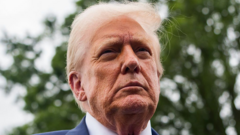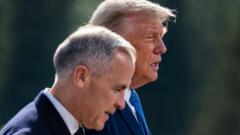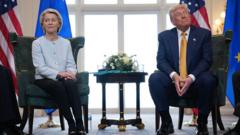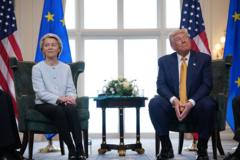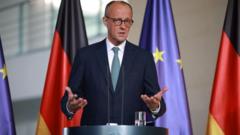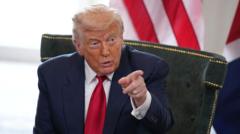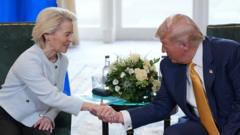U.S. and E.U. trade officials are engaged in negotiations to avert impending tariffs, yet differing priorities pose significant challenges.
U.S.-E.U. Trade Negotiations: A Path to Resolution or Further Complications?

U.S.-E.U. Trade Negotiations: A Path to Resolution or Further Complications?
Leaders strive for a trade agreement amid lingering tariff disputes as talks intensify.
In recent developments, the U.S. and the E.U. have initiated trade negotiations after President Trump announced a delay on imposing 50 percent tariffs on all European imports. This decision aims to foster constructive dialogue between the two entities. E.U. trade commissioner Maros Sefcovic confirmed his commitment to the negotiations in a social media post, emphasizing a shared objective of reaching an agreement by July 9, when the tariffs are currently scheduled to take effect.
On Memorial Day weekend, President Trump held a phone conversation with Ursula von der Leyen, the president of the European Commission, which was noted by commission spokesperson Paula Pinho to have provided a fresh impetus for the ongoing discussions. However, both sides continue to face challenges rooted in divergent priorities and goals.
The European Union has reiterated its proposal to remove tariffs on industrial goods entirely. In contrast, it is also fine-tuning lists of retaliatory tariffs, which could target U.S. imports that include machinery, soybeans, and bourbon. Nevertheless, significant obstacles lie ahead; the Trump administration has insisted on reforms to the European consumption tax system and key digital regulations, demands which E.U. officials have signaled they are not willing to entertain.
As negotiations progress, the success of averting the tariffs remains uncertain, with pressing economic implications for both sides at stake. This negotiation could pave the way for a more balanced trade relationship—or exacerbate existing tensions.
On Memorial Day weekend, President Trump held a phone conversation with Ursula von der Leyen, the president of the European Commission, which was noted by commission spokesperson Paula Pinho to have provided a fresh impetus for the ongoing discussions. However, both sides continue to face challenges rooted in divergent priorities and goals.
The European Union has reiterated its proposal to remove tariffs on industrial goods entirely. In contrast, it is also fine-tuning lists of retaliatory tariffs, which could target U.S. imports that include machinery, soybeans, and bourbon. Nevertheless, significant obstacles lie ahead; the Trump administration has insisted on reforms to the European consumption tax system and key digital regulations, demands which E.U. officials have signaled they are not willing to entertain.
As negotiations progress, the success of averting the tariffs remains uncertain, with pressing economic implications for both sides at stake. This negotiation could pave the way for a more balanced trade relationship—or exacerbate existing tensions.

